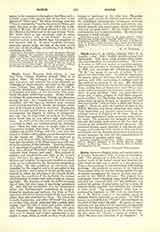

Doyle JOHN, b. in Dublin, Ireland, 1797; d. in London, January 2, 1868; English portrait-painter and caricaturist. This clever artist studied under Gabrielli, and Comerford, the miniature-painter. He came to London in 1821 and started as a portrait-painter, but gave his attention to drawing caricatures in 1827 or 1828, and developed his well-known signature, “H. B.”, by means of two sets of initials “J. D.” placed one above the other. In 1829 he commenced his famous series of drawings which he continued to produce until 1851, caricaturing in brilliant style all the political movements of the day. His drawings differ completely from the caricatures which preceded them, notably those of Rowlandson and Gillray, inasmuch as they are marked by reticence, courtesy, and a sense of good breeding. They are extraordinarily clever and at times stinging in their bitter epigrammatic quality; but Thackeray underestimated their power when he spoke of them as “genteel” and said that they would “only produce a smile and never a laugh”. There are some six hundred of them in the British Museum, and taken altogether they form a most interesting and graphic representation of the political history of England of the time. Doyle retired from professional work seventeen years before his death. He preserved his incognito to the very last and few people were aware of the fact that the initials on the caricatures formed his signature. He produced several pencil sketches of well-known personages and made use of his studies in this way in his caricatures, but the sketches themselves constitute in several instances the most lifelike representations of the persons in question which exist.
GEORGE CHARLES WILLIAMSON

